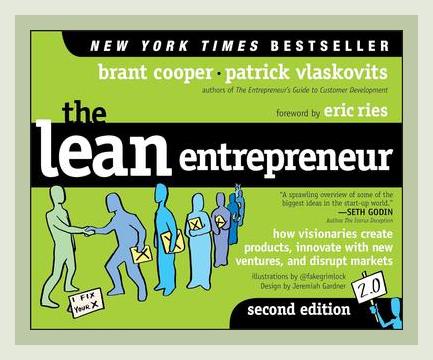Entrepreneurship and StartupsStartup StrategiesLean StartupsTech Startups
Summary: The Lean Entrepreneur by Brant Cooper and Patrick Vlaskovits
Introduction
“The Lean Entrepreneur” (2013) by Brant Cooper and Patrick Vlaskovits offers a detailed guide on implementing lean startup principles to transform ideas into scalable businesses. This book emphasizes practical strategies, user insights, and iterative experimentation for entrepreneurs in technology and startup ecosystems. It is packed with concrete examples and actionable steps, making it a valuable resource for anyone looking to navigate the uncertain waters of startup creation.
Major Concepts and Key Takeaways
1. Lean Startup Principles
Concept: Lean startup principles emphasize validated learning, rapid experimentation, and customer feedback.
Example: The authors illustrate how Intuit employed lean principles to innovate with their QuickBooks product. They leveraged customer feedback to develop and iterate on new features quickly.
Action: Start with a Minimum Viable Product (MVP) that addresses the key pain points of your target audience and gather continuous feedback to iterate on the product.
2. Finding the Right Market
Concept: Identifying early adopters who are eagerly searching for a solution to their problems.
Example: Invoking the story of Dropbox, the book shows how the founders identified tech-savvy users who needed easier file sharing solutions as their initial market.
Action: Conduct interviews and surveys to understand the current pain points of your potential customers and ensure that your product concept resonates with early adopters.
3. Customer Development
Concept: Customer development is about getting outside the building to test hypotheses about market needs.
Example: The tale of Votizen is shared, where the founders tested their assumptions about political engagement by directly engaging with potential users.
Action: Develop a set of hypotheses about your customer needs and conduct in-person interviews or online surveys to validate these hypotheses.
4. Value Hypothesis
Concept: The value hypothesis tests whether a product or service really delivers value to customers once they are using it.
Example: The authors cite how Wealthfront, a financial advisory firm, validated its value hypothesis by engaging with early adopters and iterating based on feedback.
Action: Create a simple version of your product to test core functionalities and measure user engagement and satisfaction through direct feedback channels.
5. Growth Hypothesis
Concept: The growth hypothesis tests how you will grow your user base once you have demonstrated value.
Example: Twitter’s adoption strategy is used to highlight how network effects can drive exponential growth once a core user group adopts the product.
Action: Focus on creating mechanisms within your product that encourage users to invite others, leveraging social networks and referral incentives to fuel growth.
6. Building Effective MVPs
Concept: MVPs should be small-scale versions of your product that can be quickly built and tested.
Example: Zappos started by testing the concept of selling shoes online with a very basic website and minimal inventory, validating demand before scaling operations.
Action: Strip your product down to the most essential feature that addresses your customers’ key problem and launch it to get real user feedback.
7. Rapid Experimentation and Iteration
Concept: Continuous experimentation and quick pivots are essential for adapting to market feedback.
Example: Aardvark, a Q&A startup, pivoted several times before finding the right model, eventually leading to its acquisition by Google.
Action: Set up a lean experiment board to outline hypotheses, tests, and outcomes. Regularly review the results and be prepared to pivot based on data insights.
8. Business Model Canvas
Concept: Using the Business Model Canvas helps visualize and iterate on your business model components.
Example: The book incorporates case studies where startups mapped out their value propositions, customer segments, and revenue streams to identify weak points.
Action: Fill out a Business Model Canvas for your startup, detailing customer segments, value propositions, and key metrics. Revisit and revise this canvas frequently based on new learnings.
9. Building Cross-Functional Teams
Concept: Small, cross-functional teams can rapidly develop and iterate on product ideas.
Example: The approach taken by the team at Pixar, which integrates various disciplines from the onset to keep the creative process fluid and responsive.
Action: Form a team with diverse skills including design, development, and marketing, fostering close collaboration and quick decision-making cycles.
10. Pivot or Persevere
Concept: Knowing when to pivot (change strategy) versus persevere (stick with current strategy) is crucial.
Example: PayPal famously pivoted from a payment service for PDA devices to an online payment processor after observing user behavior.
Action: Identify key performance indicators (KPIs) related to user acquisition and engagement. Use these KPIs to decide whether to pivot or persevere with your current strategy.
11. Importance of Vision
Concept: A strong vision guides the overarching strategy, whereas day-to-day activities are driven by data and experiments.
Example: The authors reference Steve Jobs’ unwavering vision for Apple, which inspired risk-taking and innovation amidst early failures.
Action: Articulate a clear vision for your startup that outlines the longer-term mission and goals. Ensure that this vision is communicated and understood by your entire team to align efforts.
12. Innovation Accounting
Concept: Innovation accounting is the practice of measuring the effectiveness of your experiments and iterations.
Example: Describing how startups can use cohort analysis to understand behavioral changes in user groups over time.
Action: Implement metrics that track user behavior and product engagement longitudinally. Use these metrics to refine your experiments and gauge progress towards your product-market fit.
Conclusion
“The Lean Entrepreneur” serves as a comprehensive manual for adopting lean startup methodologies. Leveraging real-world examples, the authors effectively illustrate how validated learning, rapid experimentation, and customer-centric strategies are pivotal for startup success. By following the actionable steps provided, entrepreneurs can navigate the uncertainty of startup environments, test and validate ideas quickly, and build scalable businesses rooted in actual market needs.
Entrepreneurship and StartupsStartup StrategiesLean StartupsTech Startups
